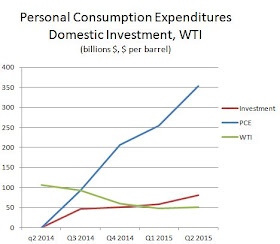Is it true that the oil price crash did not translate into higher consumption?
This graph below tells the story. Starting from Q2 2014 when the price of WTI crude was $105 (green line). You can see that Personal Consumption Expenditures (blue line) rose by an additional $353 billion, cumulative, over the ensuing four quarters.
.
The reddish brown line is Non-Residential Private Domestic Investment. Even that rose, though not by much. (Oil effect.)
The economy grew more slowly because imports increased so yes, there was leakage. However, demand was strong.

gasoline sales must have a very shitty multiplier.... must go right to savings....
ReplyDeleteYes, so say very smart people.
ReplyDeleteA different look at PCE vs. oil prices.
ReplyDeleteSeveral points:
-- unless there is a recession, PCE generally goes up, no surprise since PCE is a big chunk of GDP. If and when PCE stops going up we'll probably be in a severe recession. During lesser recessions PCE merely goes up at a slower rate, since even during recessions people still have to eat and the population continues to grow.
-- in fact PCE has only gone negative one time since FRED began tracking it in 1960. That one time was the GFC.
-- I get the impression that PCE is not adjusted for inflation? That might partly explain why PCE has always gone up except during the GFC?
-- there appears to be a weak correlation between oil prices and PCE, which makes sense to the extent that both are related to aggregate demand. Clearly PCE is related to aggregate demand, while oil prices are more complicated, depending on the Sauds, etc..